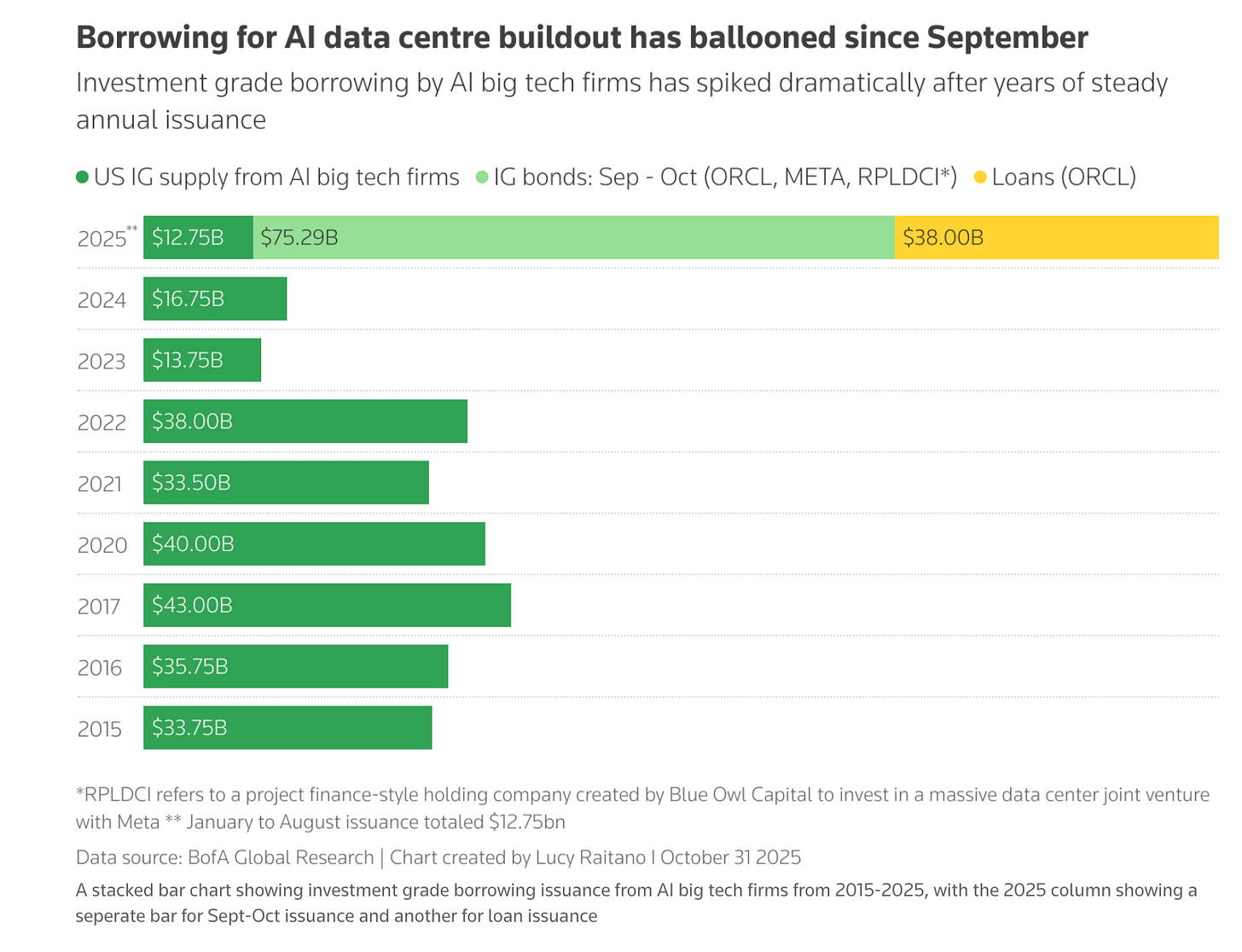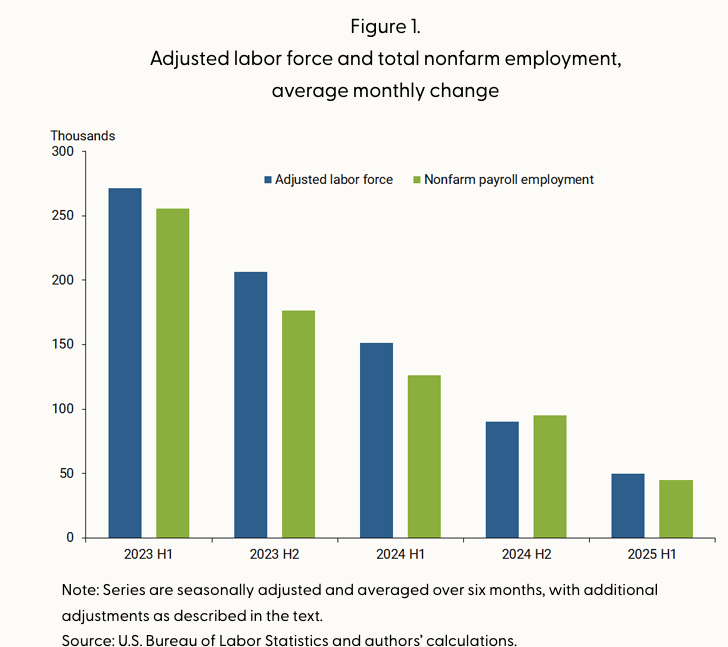Special Saturday Edition.
Posted earlier today at Political News Items.
1. Paul Kedrosky newsletter (Part One):
In 2025, borrowing by AI big tech firms for data center buildout is set to soar to over $126 billion—more than triple any previous year—driven by a dramatic spike in bond and loan issuance since September. (Source: paulkedrosky.com)
2. The Wall Street Journal:
As OpenAI ramps up its spending on data center capacity to unheard of levels, the company is hoping the federal government will support its efforts by helping to guarantee the financing for chips behind its deals, Friar said. The depreciation rates of AI chips remain uncertain, making it more expensive for companies to raise the debt needed to buy them.
“This is where we’re looking for an ecosystem of banks, private equity, maybe even governmental, the ways governments can come to bear,” she said. Any such guarantee “can really drop the cost of the financing but also increase the loan-to-value, so the amount of debt you can take on top of an equity portion.”
Friar said OpenAI could reach profitability on “very healthy” gross margins in its enterprise and consumer businesses quickly if it weren’t seeking to invest so aggressively. (Source: wsj.com. Italics mine)
3. Paul Kedrosky’s newsletter (Part Two):
The recent flare-up around OpenAI’s semi-proposed debt backstop reveals the structural tension between venture-style growth and infrastructure-scale spending, especially when the two become wrapped in the flag. The company’s CFO’s comments floated the idea of a government guarantee for data-center financing — a remarkable signal that AI build-out costs have reached utility proportions. Sam Altman’s follow-up disavowed any such plan, saying OpenAI should “fail if we get it wrong,” but the damage was done. Investors now see an enterprise straddling the line between startup and state-sponsored critical infrastructure, with an overlay of an implied “Greenspan put”—that AI is so important it can’t be allowed to fail.
The optics matter: lenders must begin to price OpenAI more like a sovereign-backed utility than a growth company. The episode marks the point where AI financing entered the quasi-public domain. Even if the “backstop” was rhetorical, it exposed how fragile the capital structure behind this compute-intensive ecosystem has become.
It has also led to umpteen thousand memes, and, amusingly, a Polymarket betting line on when Sam Altman finds himself a new house. (Sources: paulkedrosky.com, marketwatch.com, businessinsider.com, polymarket.com)
4. Paul Kedrosky newsletter, (Part Three):
Connecting data centers to the grid has now turned into open warfare between tech firms and utilities. Amazon’s complaint against PacifiCorp — filed with the Oregon Public Utility Commission — accuses the Berkshire Hathaway-owned utility of failing to deliver sufficient power to four new data-center campuses. The filing alleges that PacifiCorp provided only partial power to one site, none to a second, and has “refused to even complete its own contracting process” for two more.
Some more tidbits:
Extraordinary remedy sought — revocation of PacifiCorp’s exclusive service territory
Amazon explicitly asks the Oregon PUC to remove its facilities from PacifiCorp’s monopoly territory and reassign them to a utility “ready, willing, and able” to serve. That’s a rare and extreme regulatory demand; territory reallocation is almost never sought, let alone by a Fortune 500 customer.Alleged unilateral “32.6% tax gross-up” demand
PacifiCorp is accused of imposing a post-contract policy change adding a 32.6% surcharge on all capital contributions—retroactively—without regulatory or contractual basis. ADS contends PacifiCorp invented this internal rule years after contract execution.
It is, as they say, bananas.
PacifiCorp’s response, that it must avoid “direct and indirect harms between customers,” highlights the underlying conflict. The utility claims it cannot endanger ratepayer affordability by over-committing generation to hyperscalers. Amazon, meanwhile, argues that PacifiCorp breached 2021 obligations and is stalling projects worth billions.Some
The episode exposes the structural tension at the core of grid policy — decarbonization mandates and utility over-eagerness for new annuity-paying loads, plus political pressure, without corresponding capacity investment. Oregon’s utilities, still operating on legacy load models, cannot finance or permit new infrastructure fast enough. In all likelihood, no-one can. The result: rationed power, legal confrontation, and an augury. (Source: paulkedrosky.com)
5. Solar Energy Industries Association:
Trump administration policies are threatening more than 500 planned solar and storage projects set to provide at least half of all planned electricity in the U.S. through 2030, according to a new analysis.
The Solar Energy Industries Association said the threatened projects would provide 116 gigawatts of capacity, with Texas constituting nearly 40 percent of the at-risk infrastructure. The findings, which rely on data from the Energy Information Administration, highlight the challenges facing the industry because of rollbacks in federal tax credits, funding cuts and policies such as new Interior Department reviews of projects.
“Political attacks on solar and storage are putting half of all power planned to come onto the grid this decade at risk, just as electricity demand from AI is exploding. These are projects that would lower costs for families, strengthen our grid, and cement America’s global competitiveness,” said Abigail Ross Hopper, president and CEO of SEIA, in a statement. (Source: seia.org, eia.gov)
6. The Guardian:
Australian households in three states will be promised access to at least three hours a day of free solar power, regardless of whether they have rooftop panels, the federal government has announced.
The “solar sharer” offer will be available to homes with smart meters – which is the majority of homes – in New South Wales, south-east Queensland and South Australia from July next year, with other areas to potentially follow in 2027.
The government said Australians could schedule appliances such as washing machines, dishwashers and air conditioners and charge electric vehicles and household batteries during this time.
The solar sharer scheme would be implemented through a change to the default market offer that sets the maximum price retailers can charge customers for electricity in parts of the country. The climate change and energy minister, Chris Bowen, said the program would ensure “every last ray of sunshine was powering our homes” instead of some solar energy being wasted.
Australians have installed more than 4m solar systems and there is regularly cheap excess generation in the middle of the day. Part of the rationale for the program is that it could shift demand for electricity from peak times – particularly early in the evening – to when it is sunniest.
This could help minimize peak electricity prices and reduce the need for network upgrades and intervention to ensure the power grid was stable. (Source: theguardian.com)
7. MarketWatch:
The mood among consumers darkened in November as the government shutdown dragged on, according to a new survey released Friday.
The University of Michigan’s consumer-sentiment index fell to 50.3 in a preliminary November reading, down from 53.6 in the prior month. That’s the lowest level since June 2022, which was the lowest level on record.
Economists polled by the Wall Street Journal had expected sentiment would slip to 53.0 from 53.6 in October. (Source: marketwatch.com)
8. Paul Kedrosky newsletter (Part Four):
The average monthly growth in both the adjusted labor force and nonfarm payroll employment declines sharply from early 2023 to mid-2025, dropping by about 80%, with both indicators nearly converging at their lowest point in 2025 H1. (Source: paulkedrosky.com)
9. Becker’s Hospital Review:
AI has been the sixth most-cited reason for U.S. job cuts so far in 2025, but the No. 2 cause of layoffs in October, Challenger, Gray & Christmas found.
The technology has been responsible for 48,414 staff reductions this year, including 31,039 in October alone, according to the executive outplacement firm’s Nov. 6 report. The Department of Government Efficiency has been the leading cause of employment cuts in 2025, followed by market and economic conditions, closings, restructurings, cost-cutting, and AI.
The 153,074 layoffs in October mark the highest total since October 2003, when widespread cellphone adoption altered the telecommunications sector. “Like in 2003, a disruptive technology is changing the landscape,” the report noted. (Source: beckershospitalreview.com)
10. Becker’s Hospital Review:
Microsoft has formed an AI “superintelligence” team that will focus on transforming healthcare with the technology.
The tech giant expects the “arrival of medical superintelligence in the next few years,” Microsoft AI CEO Mustafa Suleyman wrote in a Nov. 6 blog post.
“We’ll have expert-level performance at the full range of diagnostics, alongside highly capable planning and prediction in operational clinical settings,” he said. “It will mean world-class clinical knowledge and intervention/treatment is available everywhere.”
The Microsoft AI Diagnostic Orchestrator was accurate in 85% of New England Journal of Medicine Case Challenge diagnoses, according to a June research paper.
“Human doctors max out at about 20%, and need to order many more expensive tests,” Mr. Suleyman wrote. “In our view, both clinicians and patients alike would welcome the extra support. This work just hints at the potential to revolutionize healthcare.” (Sources: beckershospitalreview.com, microsoft.ai)
11. Microsoft AI CEO Mustafa Suleyman:
At the same time we have to ask ourselves, how are we going to contain (secure and control), let alone align (make it “care” enough about humans not to harm us) a system that is – by design – intended to keep getting smarter than us? We simply don’t know what might emerge from autonomous, constantly evolving and improving systems that know every aspect of our science and society.
And since this kind of superintelligence can continuously improve itself, we’ll need to contain and align it not just once, but constantly, in perpetuity.
And it gets more complicated. It’s not just the “we” in today’s frontier AI research labs that have to do it. All of humanity needs to do it, together, all the time. Every commercial lab, every start up, every government, all need to be constantly alert and engaged in a project of alignment and containment, and that’s before we even deal with the bad actors and the crazy garage tinkerers.
No AI developer, no safety researcher, no policy expert, no person I’ve encountered has a reassuring answer to this question. How do we guarantee it’s safe? If you think that’s overly dramatic, I’d love to hear your rebuttal. Perhaps I’m missing something.
Creating superintelligence is one thing; but creating provable, robust containment and alignment alongside it is the urgent challenge facing humanity in the 21st century. And until we have that answer, we need to understand all the avenues facing us – both towards and away from superintelligence, or perhaps to an altogether alternative form of it. (Source: the-coming-wave.com, microsoft.ai)
12. A note about Paul Kedrosky.
Paul is an investor in private and public companies, as well as a writer and researcher. Originally trained as an engineer, he went on to do a Ph.D. at the University of Western Ontario in Canada, where he researched aspects of the economics of technology—specifically, the role of path dependency and network effects in risk & complexity.
Paul regularly speaks at private and public events across the U.S. and around the world, usually on topics related to risk finance, economics, the future of work, and artificial intelligence. He is currently a research fellow at MIT’s Institute for the Digital Economy, where he is studying artificial intelligence, economic disruption, and the future of work.
You can find his daily note at paulkedrosky.com. He offers a five-day preview here. Go for it. It’s terrific.




Outstanding column. You do a great job of identifying the bewildering, mind-numbing pace of change and variability of outcomes across science, health, technology, learning, governance, workforce, finance and more.